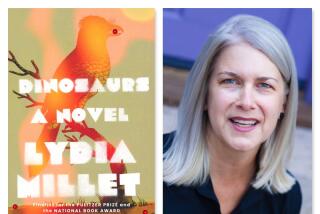The Feathering of Ferocity
- Share via
Get yourself within earshot of a child of 8 or 9 or 10 who has just learned the latest dinosaur revelations, and you’ll hear the disappointed diminuendo groan: “Aw, maaaaan!”
Wouldn’t you be peeved, too? By that age, they’ve fled the empurpled embrace of Barney for real dinosaurs--nature red in tooth and claw, huge and fearsome beings with ornate names, creatures meaner and scarier than mom and dad and the principal and the playground bully, all in one.
And now this?
The discovery of a Chinese fossil of exquisite detail has led researchers to opine that many carnivorous dinosaurs--perhaps even T. rex himself--had feathers. Like doves, like hummingbirds, like canaries. Think Big Bird, with incisors.
The find is significant for scientists as another link forged in the millennial chain from present-day birds to these vanished saurians, the most durable species ever to walk the earth. (History’s jury is still out on game show hosts and the Rolling Stones.)
But the find is just as significant for a 10-year-old who relishes the imagined mayhem and gore wrought by creatures who are safely extinct, but were strong enough to dismantle a Buick and ugly enough to crack a mirror.
Imagine a 12-ton Odette, the ballerina princess in Swan Lake, its plumage bouncing as it flutters up and bends down ever so gracefully--and bites your head off.
The notion of a feathered killer goes against every bit of mythology, violates every snake-in-Eden stained- glass window: demons have scaly, leathern wings and the good guys, cherubim and seraphim, waft on wings of angel-down.
To find out that the exceptionally cool and magnificently gross T. rex might have been as feathered as the NBC peacock, as fluffy as an Easter chick--well, who could be afraid of that?
*
Most kids go through a dinosaur phase as surely as they go through a food-quirk phase. The enthralling, tongue-twister names--ankylosaur, compsognathus--hold the power and pleasure of a secret language that walls out the grown-ups.
For dino-smitten kids, says Irene Goldenberg, a psychologist in UCLA’s psychiatry department, “it’s a real thing with scientific facts and ideas they can put together . . . whereas children who are fearful have monsters that are indefinable, not something you master intellectually but something that frightens you,” something nameless and faceless.
Poor old Bruno Bettelheim has been pretty much consigned to the ash heap of psychoanalysis, but I still think he was right, about kids reading scary fairy stories for goose bump catharsis, to scale down and master their terrors.
UCLA child and adolescent psychiatrist Dr. David Feinberg told me that a lot of the icky charm of dinosaurs lies in their unknownness, which creates anxiety and can also enable a child to project those anxieties and fears onto something else.
Then he put his daughter, Rachel, on the phone. She is “5 and 11 quarters” and she said this in one breath: “They’re extinct and very hard to find their bones and put them together the right way and they have fancy names and do a lot of fighting.”
That’s who I needed to hear from--experts. Jose Avalos came to the county Museum of Natural History with his pals for his 11th birthday. He wants to be a paleontologist. In five years he’ll be begging for wheels, but this year he pleaded for a $10,000 T. rex skull. One time he crossed his T. rex model with Mr. T. It had a mohawk and a gold chain. It did not have feathers.
“I’d still like ‘em” if they do have feathers, he said loyally, but his friend Mike Bigham, gazing into the bunny cage, said, “it’d be more like a pet then,” and added hopefully, “but still ferocious.”
Don’t fret, guys. Plucked or plumed, they’ll do for awhile yet, until you discover a really scary species--the opposite sex.
*
Actually, the news from China was the best lesson a kid could get in the workings of science. One of science’s biggest intramural topics is also the biggest misconception about it: how science changes its mind--and that it is willing to change it at all.
Michael Shermer runs the Skeptic Society in Pasadena and publishes Skeptic magazine, and he finds that some folks have gotten it into their heads “that scientists are close-minded,” when the point of science “is breaking out of the box,” testing, formulating, challenging, reformulating--a disciplined if not always polite process of “sez you--oh yeah?”
In the short years of dino-study, Goldilocks theories of their extinction thrived: The Earth was too hot or too cold, there were too few males or too many. The idea that a mountain-sized asteroid could have smacked into Earth and created a death-dealing, nuclear-style winter was blown off, until evidence of such an impact turned up in the Yucatan.
*
“Hope,” wrote Emily Dickinson, “is the thing with feathers that perches in the soul.”
The day I was at the museum, among the bones of the dear departed, the announcement came that another “Jurassic Park” dinosaur film will be made, the third in the set.
Funny if the thing with feathers turns out to be a velociraptor . . . and hope is the thing that perches at the box office.
Patt Morrison’s column appears Wednesdays. Her e-mail address is patt.morrison@latimes.com







